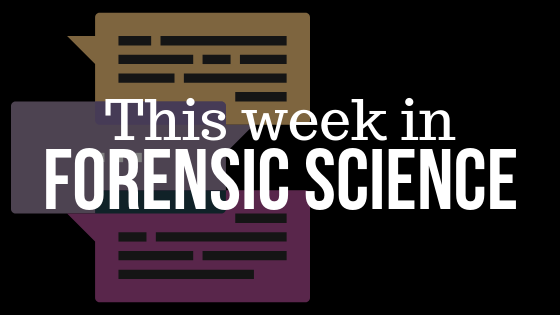No one has hours to scour the papers to keep up with the latest news, so we’ve curated the top news stories in the field of Forensic Science for this week. Here’s what you need to know to get out the door!
A Leading Cause for Wrongful Convictions: Experts Overstating Forensic Results (New York Times – 4/20/2019)
These three men spent decades in prison as a result of statistical exaggerations. They were among 150 men and women released from prison after their wrongful convictions were overturned in 2018.
Cold Case Grant Available (Forensic Magazine – 4/23/2019)
- On March 28th, the NIJ released a competitive grant solicitation titled “Prosecuting Cold Cases Using DNA and Other Forensic Technologies.” This grant solicitation is the result of the Justice Served Act that was passed in October 2018 and is designed to provide funds for the prosecution of crimes solved through DNA testing. The act authorizes the use of funds under the Debbie Smith Act to provide the $5.5 million dollars available under this grant.
UK Government Publishes New Action Plan to Improve Police Forensics (Forensic Magazine – 4/23/2019)
The U.K. Home Office today publishes a 13-point action plan to improve police forensics.
These commitments are designed to improve public confidence, support the criminal justice system and ensure the quality and stability of forensics provision.
The plan is published alongside the findings of a Home Office commissioned review into the provision of forensic services in policing, such as DNA and fingerprint evidence. It finds that urgent action is required to make the current system sustainable.
This Florida Grandfather’s Genealogy Hobby Helped Catch the Golden State Killer (WTSP – 4/23/2019)
The 80-year-old Lake Worth resident has no law enforcement background, but his work has landed dozens of criminals behind bars.
Oregon Senate Unanimously Passes Bill Making DNA Testing Accessible (KXL – 4/23/2019)
On Tuesday, the Oregon Senate took a step toward lowering the barriers after it unanimously passed a bill that modifies procedures by which person convicted of a felony initiates proceedings to obtain DNA testing.
What the Golden State Killer Tells Us About Forensic Genetics (WIRED – 4/24/2019)
In the year since the arrest of the Golden State Killer, investigative genetic genealogy has emerged as the most powerful crime-fighting tool since DNA itself.
DNA Gives Insight into Prehistoric Bonds Between Dogs and Humans (Phys Org – 4/24/2019)
Domestic dogs come in all shapes and sizes, but the animals we now regard as man’s best friend may have originated from just two populations of wolves, research suggests. The findings, along with studies on other domesticated animals, are providing new insights into how our ancestors’ lives and movements transformed these creatures forever.
Barbara Rae-Venter (Time 100 – 4/24/2019)
A profile of Barbara Rae-Venter and how her work helped to catch the Golden State Killer by Paul Holes
Sooner or Later Your Cousin’s DNA is Going to Solve a Murder (The New York Times – 4/25/2019)
The Golden State Killer case was just the start. Hundreds of cold cases are hot again thanks to a new genealogy technique. The price may be everyone’s genetic privacy.
National DNA Day and the Birth of Investigative Genetic Genealogy (NIST – 4/25/2019)
On National DNA Day last year, criminal investigations involving DNA evidence took a dramatic step forward when the Sacramento, California, district attorney announced the arrest of 72-year old Joseph DeAngelo. This arrest had come using a game-changing nontraditional approach.
DHS S&T’s Rapid DNA Technology Identified Victims of California Wildfire (Forensic Magazine – 4/25/2019)
With the help of Rapid DNA technology, medical examiners were able to provide quicker closure for many families as compared to the weeks or months it can take to produce results in a traditional forensic lab. Funded in part by the Department of Homeland Security (DHS) Science and Technology Directorate (S&T), Rapid DNA technology positively identified 85 percent of the victims in the aftermath of the disaster. Two victims remain unaccounted for as of February 7, 2019.
SWGDAM Approves Next-Gen DNA Interpretation Guidelines (Forensic Magazine – 4/25/2019)
The Scientific Working Group on DNA Analysis Methods (SWGDAM) released its interpretation guidelines for next-gen sequencing (NGS) on Wednesday. The step answers the call of the U.S. National DNA Index System (NDIS) Procedures Board to provide ground rules for approving some systems that are ready to start providing analyses.
What Does DNA Look Like? After 66 Years, We’re Still Learning More. (Forbes – 4/25/2019)
We’ve come a long way since 1953, but there’s still more to be discovered, and new imaging and computational technologies are always revealing more details about what DNA really looks like.
FBI Partnership Puts Dent in Sexual Assault Evidence Backlogs (FOX News – 4/25/2019)
Five years ago, the two government agencies teamed up with local law enforcement to tackle the issue, and chip away at the massive backlogs of untested Sexual Assault Kits (SAKs) that have been creating headaches for crime-solvers nationwide.
WOULD YOU LIKE TO SEE MORE ARTICLES LIKE THIS? SUBSCRIBE TO THE ISHI BLOG BELOW!
SUBSCRIBE NOW!


